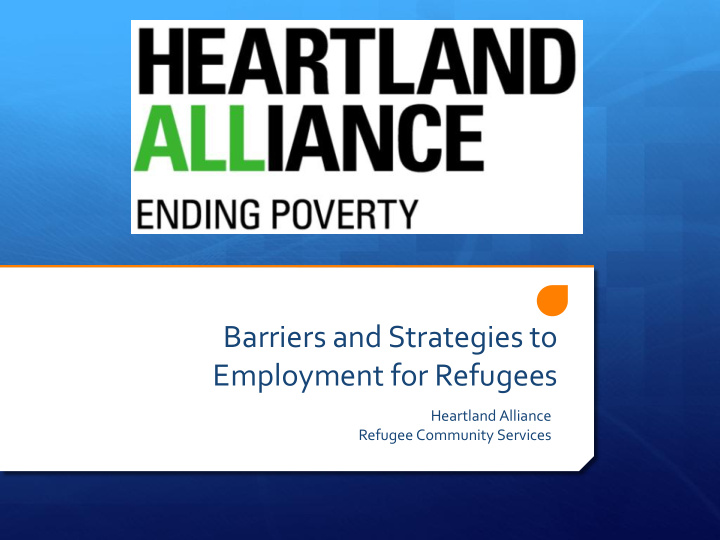



Barriers and Strategies to Employment for Refugees Heartland Alliance Refugee Community Services
Overview of Presentation Refugee Resettlement 101 Barriers that Heartland’s participants face when seeking employment and strategies for overcoming them Examples of how we implement these strategies in the Hospitality and Food Service Programs at Heartland
Refugee Resettlement 101 What is a refugee? Basic overview of resettlement process Work authorized when they arrive as refugees
Barriers: Strength-based approach to overcoming barriers Trauma Language Barriers Cultural Differences Discrimination Low-skill levels or skill set in seemingly unrelated fields Low confidence levels
Strategies Trauma: Mental Health support and providing community support within the office setting and Trauma-informed care Language Barriers: ESL classes and Trainings (and community support within the office setting…more opportunity to practice English and feel less inhibited to speak the language) Cultural differences: Classes and Trainings Discrimination: Partner with companies that see their value Low Skills Levels: More trainings AND more partnerships with companies that see the value of transferable skills Low confidence levels: Group trainings and strength based teaching approach. And providing community support in our office
Example of barriers and strategies through Hospitality and Food Training Trauma: maintaining a safe environment in the classroom where people can feel hopeful and not judged. Referring ppts to mental health services if needed Language Barriers: create a fun and safe classroom where people will not feel judged by their English levels. Positive approach! Cultural Differences: discussing cultural differences consistently and often! Used as a teaching moment vs. a judgmental moment Discrimination: working with companies that value different languages, cultures and backgrounds Low-skill levels or skill set in seemingly unrelated fields: working with partners who are able to see how our ppts ’ tranferable skills will benefit the team Low confidence levels: creating a safe environment in the classroom. Showing students the gains they’ve made as the class progresses, and marking the end of the training with a celebratory event.
Program in Action!
Takeaway: how to effectively serve refugee job seekers Collaborate with the participant’s resettlement agency Refer participant to ESL and training programs Focus on transferable skills Understand the refugee’s strengths and qualities so that you can effectively highlight this to employers Be trauma-informed Understand the complex reality and barriers that refugees face
Contact information Jay Landau Director of Education and Program Development jlandau@heartlandalliance.org Soren Larsen-Ravenfeather Youth Case Manager sravenfeather@heartlandalliance.org Nancy Joyce Callahan Vocational Hospitality Training Coordinator ncallahan@heartlandalliance.org
Recommend
More recommend